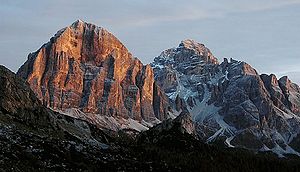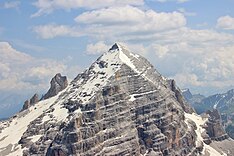Tofana di Rozes
| Tofana di Rozes | ||
|---|---|---|
|
Tofana di Rozes south face and Tofana di Mezzo |
||
| height | 3225 m slm | |
| location | Belluno , Italy | |
| Mountains | Tofane , Dolomites | |
| Dominance | 1.8 km → Tofana di Mezzo | |
| Notch height | 664 m ↓ Forcella Fontananegra | |
| Coordinates | 46 ° 32 '13 " N , 12 ° 3' 4" E | |
|
|
||
| rock | Main dolomite | |
| Age of the rock | Upper Triassic | |
| First ascent | Paul Grohmann , Francesco Lacedelli , Angelo Dimai and Santo Siorpaes on August 29, 1864 | |
| Normal way | North flank ( I ) | |
| particularities | 800 meter high south wall ( Tofana Sud ) | |
The Tofana di Rozes (also Vordere Tofana or Tofana I ) is a 3225 m slm high mountain in the Dolomites in the Italian province of Belluno . With its famous south face, it forms the most impressive, albeit lowest, elevation of the three-peaked Tofane west of Cortina d'Ampezzo .
Location and surroundings
The Tofana di Rozes is the southernmost of the three Tofana peaks and is separated from the Tofana di Mezzo by the Forcella Fontananegra ( 2561 m ). In this area are the Rifugio Giussani and the no longer managed Rifugio Cantore. In the west the Forcella Bois ( 2331 m ) separates the rock colossus from the Lagazuoistock , in the west and north the Val Travenanzes forms the border to the Fanes group . Seen from the north, the mountain appears as a triangular rock pyramid, to the south it shows one of the most imposing walls of the Dolomites, which is usually referred to as Tofana Sud . Despite the lowest summit height, the mountain is the most famous motif of the Tofane, precisely because of this 800 meter high south face. In the lower section of the wall there is the Grotta della Tofana, a cave several meters deep , which Paul Grohmann has already visited.
Alpinism
The first ascent was made on August 29, 1864 by Paul Grohmann with the locals Francesco Lacedelli , Angelo Dimai and Santo Siorpaes . Grohmann and Lacedelli had already climbed the Tofana di Mezzo for the first time the year before. Similar to their development, they chose the ascent from the Forcella Fontananegra over the northeast flank, today's normal route. Grohmann was enthusiastic about the view from the summit:
"I am not a fan of counting countless mountain peaks to describe a view, and I refrain from doing this here too, but a detailed picture of the panoramic view remains unforgettable for me: the terrible crags of the other two Tofan peaks in close proximity, and between these the Gaisl looks ahead, the Croda rossa of the Ampezzoans; only the uppermost part, but this blood red, a strange contrast to the gray limestone walls of the Tofana! "
In August 1901 Ilona and Rolanda von Eötvös mastered the colossal south face for the first time with Antonio Dimai, Giovanni Siorpaes and Agostino Verzi. The Via Eötvös-Dimai ( IV ) is now one of the classic routes in the Dolomites. The wall, conspicuously structured by massive pillars, was climbed on almost 30 different routes in the course of the 20th century. The most important include the second pillar ( Secondo Pilastro , VI ), which Ettore Constantini and Luigi Ghedina conquered for the first time in 1946, or the Via delle Tridentina (also VI ) opened in 1952 by Walter Bonatti and P. Contini . Angelo Dibona , Walter Stößer and Attilio Tissi made other important first ascents .
During the First World War , the Tofana di Rozes was a particularly hotly contested mountain. On July 22, 1915, a patrol of the third Jäger Regiment in the German Alpine Corps took the previously unoccupied summit as part of the First Dolomite Offensive. The Tofana I could be defended against the Italians until September 18.
Ascent
Despite its imposing appearance, the Tofana di Rozes is - apart from the cable car access to the Tofana di Mezzo - the easiest to climb from the three Tofana peaks. The non-climber has two options for the ascent to Tofana di Rozes.
- The normal route leads from Rifugio Giussani ( 2580 m ) easily over scree-covered rock to the northwest ridge and over this finally to the summit. Firn residues are not uncommon in the upper area.
- A second variant is the Via ferrata Giovanni Lipella, opened in 1967 ( difficulty C / D ). This is mostly tackled from the Rifugio Angelo Dibona ( 2083 m ). The path first leads under the mighty south wall to the entrance, where a steep tunnel has to be crossed. The trail then runs north on the west side of the mountain to the Tre Dita ( 2694 m ) and finally makes a bend to the south. After getting off you reach the normal route and over it the summit.
Web links
Individual evidence
- ^ A b Paul Grohmann : Hikes in the Dolomites. Verlag von Carl Gerold's Sohn , Vienna 1877, pp. 98–101. [1]
- ↑ Via Eötvös Dimai. Mountain Network srl, accessed June 24, 2016 (Italian).
- ^ Tofana di Rozes - 1 ° Spigolo. Pareti Verticali, accessed June 24, 2016 (Italian).
- ↑ Via Dimai alla Tofana di Rozes. Sergio Ramella, accessed June 24, 2016 (Italian).
- ↑ a b Horst Höfler & Paul Werner: Via ferrata in the Dolomites. With the Vicentine Alps, Brenta and Lake Garda mountains. Bergverlag Rother , Munich 2000, pp. 110–111. ISBN 3-7633-3096-8 .


